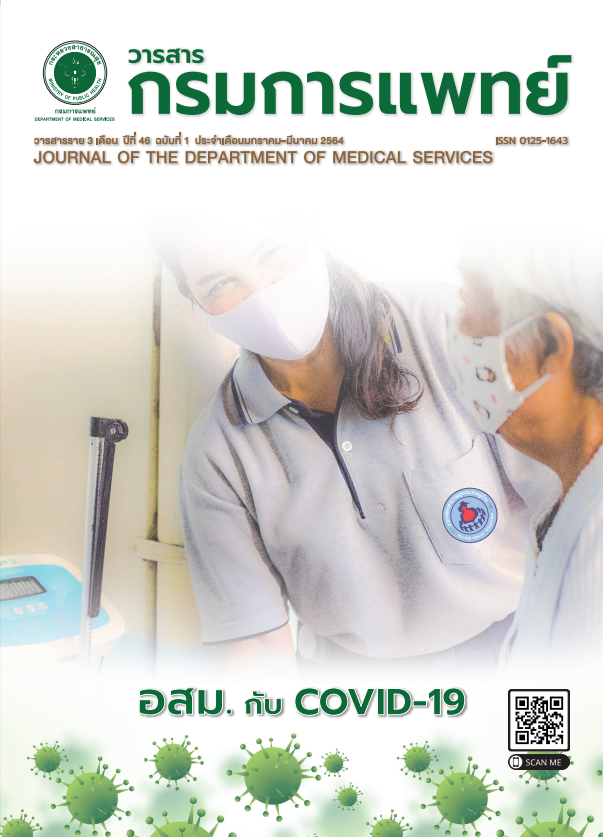The Evaluation of Saccular Function in Definite Meniere’s Disease Patients by Cervical Vestibular Evoked Myogenic Potentials (cVEMPs)
Keywords:
Meniere’s disease, Saccular function, Vestibular-evoked myogenic potentialAbstract
Background : Meniere’s disease demonstrates abnormal function of both auditory and vestibular system. Abnormalities in saccule was the second most common finding in histopathology study. The previous studies showed inconsistent results in saccular function.
Objective : To evaluate saccular function in definite Meniere’s disease patients by cervical vestibular evoked myogenic potential (cVEMP).
Method : A cross-sectional study conducted at King Chulalongkorn Memorial Hospital. All patients in control group and definite Meniere’s disease underwent cVEMP. Four parameters of cVEMP include P1 latency, N1 latency, P1-N1 amplitude and amplitude asymmetry ratio were evaluated.
Result : Twenty-two definite Meniere’s disease and thirty control patients were included in the study. The median duration of Meniere’s disease was 36 months. Nineteen of twenty-two Meniere’s disease patients (86.36%) obtained absence cVEMP in affected ear. The mean latency of P1, N1 and P1-N1 amplitude were not statistically significant different between control group and unaffected ear of Meniere’s disease group (mean difference = 0.73, 95% CI = -1.55, 0.08, p = 0.074; mean difference = 0.25, 95% CI = -1.23, 0.74, p = 0.62; mean difference = -5.45, 95% CI -1.44, 12.34, p = 0.12, respectively). Three Meniere’s disease patients who cVEMP presented in affected ear showed amplitude asymmetry ratio of 24.4%.
Conclusions : Patients with definite Meniere’s disease usually demonstrated absent cVEMP response.
References
Zhou G, Cox LC. Vestibular evoked myogenic potentials: history and overview. Am J Audiol 2004; 13:135-43.
Kushiro K, Zakir M, Ogawa Y, Sato H, Uchino Y. Saccular and utricular inputs to sternocleidomastoid motoneurons of decerebrate cats. Exp Brain Res1999; 126:410-6.
Crane BT, Schessel DA, Nedzelski J, Minor LB. Peripheral vestibular disorders. In: Flint PW, Haughey BH, Lund WJ, Niparko JK, Richardson MA, Robbins KT, eds. Cummings otolaryngology Head and Neck surgery. 5th ed.Philadelphia, USA: Elsevier,2010:2328-46.
Alexander TH, Harris JP. Current epidemiology of Meniere’s syndrome. Otolaryngol Clin N Am 2010; 43:965-70.
Albers FW, Van Weissenbruch R, Casselman JW. 3DFT magnetic resonance imaging of the inner ear in Meniere’s disease. Acta Otolaryngol 1994; 114:595-600
Committee on Hearing and Equilibrium guidelines for the diagnosis and evaluation of therapy in Meniere’s disease.AAO-HN Foundation, Inc. Otolaryngol Head Neck Surg 1995;113:181-5.
Committee on Hearing and Equilibrium guidelines for the diagnosis and evaluation of therapy in Meniere’s disease.AAO-HN Foundation, Inc. Otolaryngol Head Neck Surg; 2015.
Gibson WP, Moffat DA, Ramsden RT. Clinical electrocochleography in the diagnosis and management of Meniere’s disorder. Audiology 1977; 16:389-401.
Goin DW, Staller SJ, Asher DL, Mischke RE. Summating potential in Meniere’s disease. Laryngoscope 1982;92:1383-9.
Campbell KC, Harker LA, Abbas PJ. Interpretation of electrocochleography in Meniere’s disease and normal subjects. Ann Otol Rhinol Laryngol 1992; 101:496-500.
Kumagami H, Nishida H, Baba M. Electrocochleographic study of Ménière’s disease. Arch Otolaryngol 1982;108:284-8.
Okuno T, Sando I. Localization, frequency, and severity of endolymphatic hydrops and the pathology of the labyrinthine membrane in Meniere’s disease. Ann Otol Rhinol Laryngol 1987;96:438-45.
Seo T, Node M, Yukimasa A, Sakagami M. Furosemide loading vestibular evoked myogenic potential for unilateral Meniere’s disease. Otol Neurotol 2003; 24:283-8.
Rauch SD, Silveira MB, Zhou G, Kujawa SG, Wall C 3rd, Guinan JJ,et al. Vestibular evoked myogenic potentials versus vestibular test battery in patients with Ménière’s disease. Otol Neurotol 2004; 25:981-6.
Lamounier P, de Souza TSA, Gobbo DA, Bahmad F, Jr.Evaluation of vestibular evoked myogenic potentials (VEMP) and electrocochleography for the diagnosis of Meniere’s disease.Braz J Otorhinolaryngol2017; 83:394-403.
Ribeiro S, Almeida RR, Caovilla HH, Gananca MM. Vestibular evoked myogenic potentials in affected and asymptomatic ears in unilateral Meniere’s disease. Braz J Otorhinolaryngol 2005;71:60-6.
De Waele C, Huy PT, Diard JP, Freyss G, Vidal PP. Saccular dysfunction in Meniere’s disease. Am J Otol 1999;20:223-32.
Murofushi T, Matsuzaki M, Takegoshi H. Glycerol affects vestibular evoked myogenic potentials in Meniere’s disease. Auris Nasus Larynx 2001; 28:205-8.
Kim MB, Choi J, Park GY, Cho YS, Hong SH, Chung WH. Clinical value of vestibular evoked myogenic potential in assessing the stage and predicting the hearing results in Ménière’s disease. Clin Exp Otorhinolaryngol2013;6:57-62.
Young YH, Wu CC, Wu CH. Augmentation of vestibular evoked myogenic potentials: an indication for distended saccular hydrops. Laryngoscope 2002; 112:509-12.
Wang HM, Tsai SM, Chien CY, Ho KY. Analysis of auditory and vestibular function in patients with unilateral Meniere’s disease.Acta Otolaryngol 2012; 12:1246-51.
Jariengprasert C, Tiensuwan M, Euasirirattanapaisan K. A comparison of vestibular evoked myogenic potential (VEMP) between definite Meniere’s disease patients and normal healthy adults. J Med Assoc Thai 2013;96:1563-8.
Dabiri S, Yazdani N, Esfahani M, Tari N, Adil S, Mahvi Z, et al.Analysis of saccular function with vestibular evoked myogenic potential test in Meniere’s disease. Acta Med Iran 2017;55:123-7.
Rauch SD, Zhou G, Kujawa SG, Guinan JJ, Herrmann BS. Vestibular evoked myogenic potentials show altered tuning in patients with Meniere’s disease. Otol Neurotol 2004; 25:333-8.
Akkuzu G, Akkuzu B, Ozluoglu LN. Vestibular evoked myogenic potentials in benign paroxysmal positional vertigo and Meniere’s disease. Eur Arch Otorhinolaryngol 2006; 263:510-7.
Downloads
Published
How to Cite
Issue
Section
License

This work is licensed under a Creative Commons Attribution-NonCommercial-NoDerivatives 4.0 International License.
บทความที่ได้รับการตีพิมพ์เป็นลิขสิทธิ์ของกรมการแพทย์ กระทรวงสาธารณสุข
ข้อความและข้อคิดเห็นต่างๆ เป็นของผู้เขียนบทความ ไม่ใช่ความเห็นของกองบรรณาธิการหรือของวารสารกรมการแพทย์



